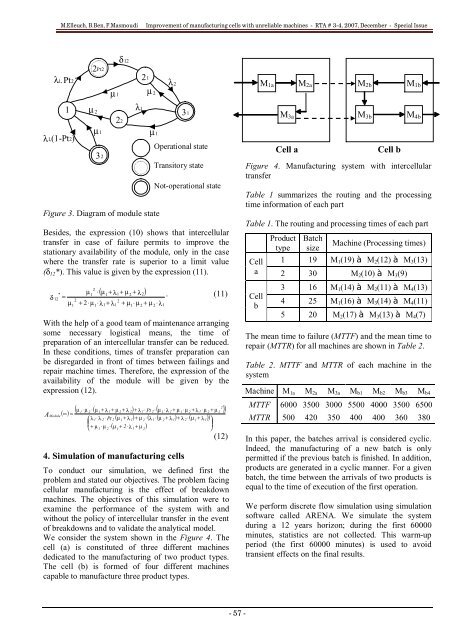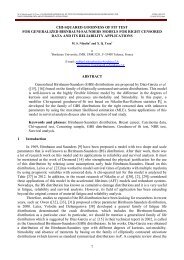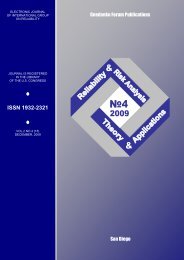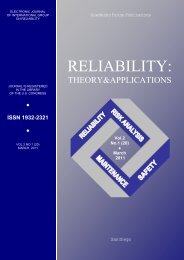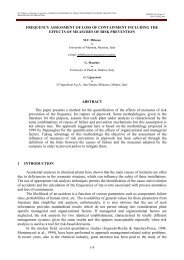Full Text in PDF - Gnedenko e-Forum
Full Text in PDF - Gnedenko e-Forum
Full Text in PDF - Gnedenko e-Forum
You also want an ePaper? Increase the reach of your titles
YUMPU automatically turns print PDFs into web optimized ePapers that Google loves.
M.Elleuch, B.Ben, F.MasmoudiImprovement of manufactur<strong>in</strong>g cells with unreliable mach<strong>in</strong>es - RTA # 3-4, 2007, December - Special Issueδ12λ1. Pt212Pt2µ 2µ 122λ121µ 2λ231M 1aM 2aM 3aM 2b M 1bM 3b M 4bλ1.(1-Pt2)Figure 3. Diagram of module stateBesides, the expression (10) shows that <strong>in</strong>tercellulartransfer <strong>in</strong> case of failure permits to improve thestationary availability of the module, only <strong>in</strong> the casewhere the transfer rate is superior to a limit value(δ 12 *). This value is given by the expression (11).δ*122µ1⋅( µ1+ λ1+µ2+ λ 2)= . (11)µ212+ 2⋅µ ⋅λ+ λ + µ ⋅ µ + µ ⋅λ1111With the help of a good team of ma<strong>in</strong>tenance arrang<strong>in</strong>gsome necessary logistical means, the time ofpreparation of an <strong>in</strong>tercellular transfer can be reduced.In these conditions, times of transfer preparation canbe disregarded <strong>in</strong> front of times between fail<strong>in</strong>gs andrepair mach<strong>in</strong>e times. Therefore, the expression of theavailability of the module will be given by theexpression (12).AModule( ∞)=22( µ ⋅ µ ⋅( µ + λ 1 + µ + λ 2) + λ 1⋅Pt 2 ⋅( µ ⋅λ2 + µ ⋅ µ + λ 1⋅µ + µ)12µ1321⎛λ1⋅λ2 ⋅ Pt⎜⎝+µ ⋅ µ ⋅1 222112 ( µ1+ λ 1) + µ2⋅( λ 1⋅( µ2+ λ 1) + λ 2 ⋅( µ1+ λ 1))( ) ⎟ ⎞µ + 2⋅λ1 +1µ2⎠(12)4. Simulation of manufactur<strong>in</strong>g cellsTo conduct our simulation, we def<strong>in</strong>ed first theproblem and stated our objectives. The problem fac<strong>in</strong>gcellular manufactur<strong>in</strong>g is the effect of breakdownmach<strong>in</strong>es. The objectives of this simulation were toexam<strong>in</strong>e the performance of the system with andwithout the policy of <strong>in</strong>tercellular transfer <strong>in</strong> the eventof breakdowns and to validate the analytical model.We consider the system shown <strong>in</strong> the Figure 4. Thecell (a) is constituted of three different mach<strong>in</strong>esdedicated to the manufactur<strong>in</strong>g of two product types.The cell (b) is formed of four different mach<strong>in</strong>escapable to manufacture three product types.µ1Operational stateTransitory stateNot-operational state1222Figure 4. Manufactur<strong>in</strong>g system with <strong>in</strong>tercellulartransferTable 1 summarizes the rout<strong>in</strong>g and the process<strong>in</strong>gtime <strong>in</strong>formation of each partTable 1. The rout<strong>in</strong>g and process<strong>in</strong>g times of each partCellaCellbCell aProducttypeBatchsizeCell bMach<strong>in</strong>e (Process<strong>in</strong>g times)1 19 M 1 (19) M 2 (12) M 3 (13)2 30 M 2 (10) M 3 (9)3 16 M 1 (14) M 2 (11) M 4 (13)4 25 M 1 (16) M 3 (14) M 4 (11)5 20 M 2 (17) M 3 (13) M 4 (7)The mean time to failure (MTTF) and the mean time torepair (MTTR) for all mach<strong>in</strong>es are shown <strong>in</strong> Table 2.Table 2. MTTF and MTTR of each mach<strong>in</strong>e <strong>in</strong> thesystemMach<strong>in</strong>e M 1a M 2a M 3a M b1 M b2 M b3 M b4MTTF 6000 3500 3000 5500 4000 3500 6500MTTR 500 420 350 400 400 360 380In this paper, the batches arrival is considered cyclic.Indeed, the manufactur<strong>in</strong>g of a new batch is onlypermitted if the previous batch is f<strong>in</strong>ished. In addition,products are generated <strong>in</strong> a cyclic manner. For a givenbatch, the time between the arrivals of two products isequal to the time of execution of the first operation.We perform discrete flow simulation us<strong>in</strong>g simulationsoftware called ARENA. We simulate the systemdur<strong>in</strong>g a 12 years horizon; dur<strong>in</strong>g the first 60000m<strong>in</strong>utes, statistics are not collected. This warm-upperiod (the first 60000 m<strong>in</strong>utes) is used to avoidtransient effects on the f<strong>in</strong>al results.- 57 -


